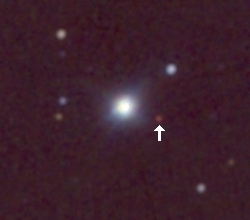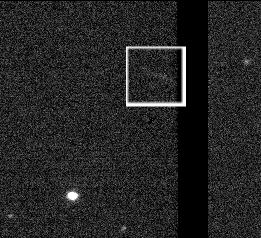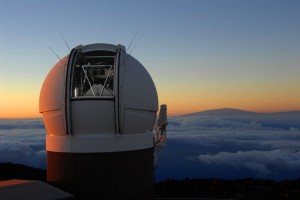What we’re doing with PS1: A brown dwarf bonanza in our backyard
January 29th, 2011 by bertrandgoldmanThe vicinity of the Solar system, the nearby few hundred light-years, has been a prime source of astronomical discoveries for many centuries. The average distance to stars that are similar to the Sun and visible to the naked eye is less than 120 light-years. This is the very neighborhood of the Sun when you think that the center of our Galaxy is located some 25,000 light-years away! Those are the stars that made up the “sphere of the fixed”, past the Moon, against which astrologers and early astronomers such as Kepler measured the movement of celestial bodies of the Solar system and eventually, let Galileo and Newton discover the law of gravity.
When the invention of the telescope in the 17th century allowed astronomers to observer fainter stars and accurately measure their position, it appeared that the “fixed stars” were not that fixed. Many showed small motions compared to other stars over the years, and some additionally show a circular, yearly motion, reflecting the revolution of the Earth around the Sun. These motions, which are greatest for the stars closest to the Earth, allowed scholars to discover the Sun’s neighbors and to measure their distance.
In the 20th century, the observations of the sky with photographic plates led to the discovery of most nearby stars more massive than a few tenths of the Sun’s mass. Today, Pan-STARRS 1 will use exactly the same methods, with greater accuracy and sensitivity, to detect all nearby stars in the Northern sky and measure their distance. The greater accuracy will allow us to expand the “Solar neighborhood” to about 250 light-years, and the greater sensitivity to detect the coolest stars, as well as compact objects not massive enough to burn hydrogen as stars do, which are called brown dwarfs.
One key project of the Pan-STARRS 1 Science Consortium is dedicated to the study of our stellar backyard. Astronomers from across the PS1SC including Eugene Magnier and Michael Liu from the University of Hawaii and I have been working to take a complete census of the nearby low-mass objects, both stars and brown dwarfs. The detection of all very-low mass stars and brown dwarfs in the Solar neighborhood may reveal the closest Solar neighbor, possibly closer than the current holder of that record, Proxima Centauri at 4 light-years. Because they are close, those objects are the brightest among their peers, so that it is possible to observe and characterize them with greater details.

2MASS J09201223+3517429 imaged by Pan-STARRS 1, indicated by an arrow. While it appears as a single red dot, it is actually a binary pair of brown dwarfs. Pan-STARRS 1 will discover hundreds of new brown dwarfs. Credit: PS1SC
Like stars, brown dwarfs form from the collapse of a huge cloud of gas. However unlike stars they cool and dim with time, because they lack an internal energy source. This makes it difficult to determine important parameters like age or mass, because a young, low-mass brown dwarf will look like an older, more massive one. Sometimes we can learn more from a stellar companion, or from the stellar cluster if the brown dwarf belongs to one.
The atmospheres of very low-mass stars and brown dwarfs have temperatures of a few hundred degrees to a few thousands Fahrenheit. Because of such a large range of temperatures, the atmospheric chemistry is diverse and complex. We know that dust clouds are present, but sometimes hidden below a layer of water and methane. The coolest known dwarfs have ammonia; even cooler dwarfs may have water ices. It seems that different dust properties change the colors of brown dwarfs, as well as the proportion of heavier elements they have, or ages. Only when we discover and characterize more objects will we understand better their properties. This will also help us to understand the atmospheres of gas giant planets around other stars. But these cold brown dwarfs won’t be the only near neighbors of the Sun we will search for with PS1.
Most of the stars in the Solar neighborhood belong to a flattened structure of our Galaxy called the Thin Disk, which we see as the Milky Way on the sky. That disk sits in a dimmer and older structure, almost spheroidal, called the Halo, which extends to great distances. A small fraction of the nearby objects are actually members of that Halo. Detecting and studying them, for instance old white dwarfs, which are the dead remnants of aged stars which were originally similar to the Sun, provides information on the Halo, such as its age and origin.
On the contrary, another small fraction of the Solar neighborhood is made of young objects which just escaped their stellar nursery, or maybe were born in isolation. Again studying them with great precision allows us to understand the formation of very low-mass stars and brown dwarfs, which may differ from both higher-mass stars, and lower-mass extrasolar planets. We can also search for young planets and gas and dust disks orbiting the young dwarfs. With the present instrument those are visible only close to the Earth.
Finally, thanks to our repeated observations of the whole Northern sky, we will discover most variable stars having variations as small as 1% in their light output. These stars may be young stars, still erratically accreting material from disks of material left over from their formation; or eclipsing stars, whose light is occasionally blocked by a companion or a planet; or magnetically active stars which show variations due to massive flares in their atmosphere.
The Solar neighborhood is a diverse mixture of stellar populations reflecting the past and present of the Galaxy. As we come to describe it more completely, we learn about the life of stars from birth to death, or their companions and planets, and of the physics that control their atmospheres and their evolutions. Pan-STARRS 1 will be a key tool in these investigations over the coming years.



